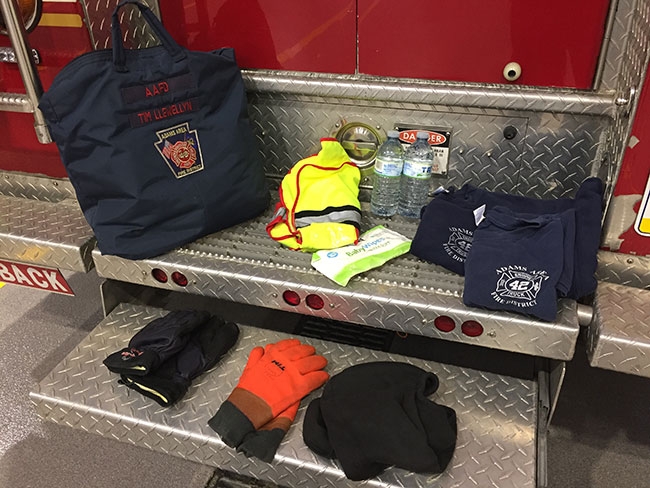
Timbits: Be prepared for anything
By Tim Llewellyn
Features Hot Topics PreventionAs a much younger man, I was taught early on in my fire service career to be prepared – for anything. In the fall of 1989, as a fresh-faced rookie, one of the first lessons I remember being offered up by a ‘salty old guy’ was to keep a pair of heavy socks in your fire boots for the colder months. Those hand-me-down rubber hip boots that were standard issue at my first volunteer fire department were minimally insulated and did little to fend off the bone-chilling winter cold. I took the advice and stuffed an old pair of wool hunting socks into the boots. However, I never actually put the socks on. It always seemed like too much work and it would take too much time to pull those rough, scratchy, stretched-out socks over my cotton ones. And besides, I didn’t want to miss the fire engine or be the last one to get on. My feet were often cold back then.
Fast-forward almost 30 years (man, time flies), I find that I am now the ‘salty old guy’ who gets to pass on tips to others. For those of you who have followed my Tim-bits articles in this fine publication for the past five years, you’ll notice that the overarching theme essentially boils down to what I was taught very early on – be prepared for anything.
As firefighters, we need to construct our hose beds to be capable and ready for a forward or reverse lay. We need to be prepared to advance, position and lay out hoselines in different manners for the greatest efficiency and effect. We need to be prepared.
In this column, I’m taking what my ‘salty old guy’ told me, and I’m adding my two cents along with what has worked well over my years of service. The preparation that I’m going to speak about is not that of training, but of personal preparedness for whatever might come our way.
My old guy told me to keep a spare pair of socks in my fire boots. My advice to all is to get a small duffle bag or backpack to hold a pair of socks and other essentials. I use a version of a pilot’s helmet bag that has served me well for several years now. It’s durable and is just the right size to hold what I might need; and not too big to get in the way in the front or back of the fire engine. I take it with me on every call; because, you know, I want to be prepared.
So, what’s inside? Nothing groundbreaking, I just keep a few things that have helped me when things didn’t go as expected. First, there are the basics: something to change into or additional layers if I get cold and/or wet. There are two pairs of socks, one thick pair and one thin. And they’re good socks that I enjoy wearing; not the stretched out, scratchy ones that I had way back when. There’s also a long sleeve t-shirt and a sweatshirt, which have come in handy in both warm and cold weather.
I keep a fresh supply of water and some kind of nourishment. Currently living in the inside pockets of my bag are two bottles of water that I change out at least every six months and two or three granola bars and/or other non-coated energy bars. I found out the hard way that the chocolate-coated protein bars are a bad idea due to their low melting temperatures. You may think that keeping food and water in a personal bag is a dumb idea if your apparatus always has water and some snacks on it – like my trucks do. But what happens if a problem arises for some reason and you find yourself not attached to that particular apparatus anymore? What if you are hungry or thirsty and the rehab wagon is still some time away? Always be prepared.
My personal bag also contains one spare pair of fire gloves and a spare fire hood. Like the socks, these items are quality and both are brand new. They are the same style and size that I use daily. In the rare occasion that your company ever finds itself going to back-to-back fires or long incidents, a dry pair of gloves and a dry hood can make a big difference for your personal comfort. And, if you lose your frontline gloves or hood, you will still be prepared to respond.
Finally, and probably most importantly, I keep a pack of baby wipes. Current research tells us that firefighters need to decontaminate their faces and necks ASAP after a fire call. Using a baby wipe after a call can help limit exposure to the harmful soot that makes its way through our gear. Also, if nature calls and you’re out in the middle of nowhere, they are a lifesaver.
Whether or not you decide to take advice is up to you. But I encourage you to ready yourself and your equipment, because in today’s world, you never know how long you’re going to be out when the call comes.
Tim Llewellyn is a firefighter for the Allegheny County Airport Authority in Pittsburgh, Pa., and an instructor for a number of fire academies and training faculties. llewellyn.fire@gmail.com
 Firefighters should consider bringing a small duffle bag or backpack to hold the essentials you might need
Firefighters should consider bringing a small duffle bag or backpack to hold the essentials you might need Print this page